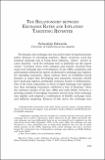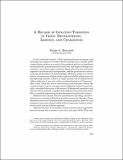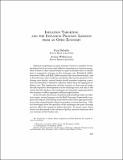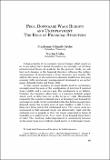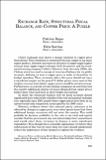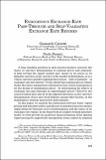Buscar
Mostrando ítems 1-10 de 32
The relationship between exchange rates and inflation targeting revisited
For decades, the exchange rate was at the center of macroeconomic policy debates in emerging markets. Many countries used the nominal exchange rate to bring down inflation, –others—mostly in Latin America—used the exchange rate to implicitly tax the export sector. Currency crises were common and usually ...
Inflation targeting in Brazil: shocks, backward-looking prices, and IMF conditionality
In mid-January 1990, Brazil abandoned its crawling exchange rate band. Surprisingly enough, the country's economic performance in the aftermath of this episode was much better than expected, given the performance of other emerging market economies after a move toward floating. Despite the large ...
A decadeof inflation targeting in Chile: developments, lessons, and challenges
In the twentieth century, Chile experienced most monetary and exchange rate regimes. Periods of fixed exchange rates usually ended in speculative attacks as a result of inconsistent policies or significant external shocks, generating serious real costs and larger exchange rate volatility.
Inflation targeting and the inflation process: lessons from an open economy
Inflation targeting in an open economy insolves a number of complexities that do not arise with inflation targeting in a clises economy. One of these is that central banks in open economies have to decide how to repond to changes in the exchange rate.
Fiscal inflation and cosmetic defaults in a small open economy
For a small open economy, maintaining a stable exchange rate and moderate levels of inflation is often a goal of primary importance. At the same time, the profession has recognized the tight link between fiscal and monetary policies in determining inflation dynamics. Thus, the goal of a stable exchange ...
The carry trade in industrialized and emerging markets
The profitability of currency carry trades in and of itself is 'economic' evidence against the uncovered interest parity (UIP) condition. There is a wide variety of 'statistical' evidence against UIP. Yet the relationship between these two types of evidence and their implications for time variation ...
Pegs downward wage rigidity and unemployment: the role of financial structure
A characteristic of the current crisis in Europe is that countries in its periphery have found themselves increasingly cut off from international financial markets. In the present study we ask how such changes in the financial structure influence the welfare consequences of maintaining a fixed exchange ...
Exchange rate structural fiscal balance and copper price: a puzzle
Chile’s exchange rate shows a strong volatility to copper price fluctuations. This correlation is essentially because copper is our main export product therefore increases in the price of copper imply higher returns from copper export volumes both for private and the stateowned mining company Codelco. ...
Endogenous exchange-rate pass-through and self-validating exchange rate regimes
A long-standing question in open macroeconomics concerns the choice of currency denomination of nominal prices and contracts. A firm serving the export market may choose to set prices in its domestic currency in the currency of the market of destination or in a vehicle currency possibly indexing these ...
Comfort in floating: taking stock of twenty years of freely floating exchange rate in Chile
Chile offers an example of a country that has overcome the fear of floating by reducing balance-sheet mismatches; enhancing financial-market development; and improving monetary, fiscal, and political institutions; while strengthening policy credibility. Under the floating regime, Chile’s economic ...

